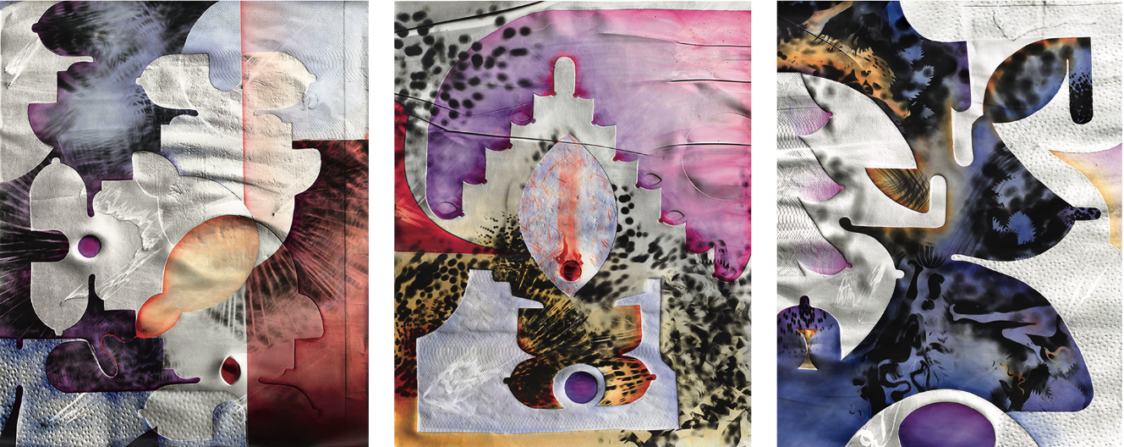
“Girl Woman Lady,”“Cascade 2,”and“Running,” unique photographic reliefs (embossed gelatin silver photograms, fabric dye) from the series Rainbow Bruise by Klea McKenna © The artist. Courtesy EUQINOM Gallery, San Francisco
Archaeologists translated cuneiform tablets recording shareholder agreements for the first company in Anatolia. People living in the Horn of Africa survived the explosion of the Toba supervolcano 74,000 years ago, and shifts in the Nile River system, such as floodplain expansion and consolidation from a wandering braided network of smaller rivers into a single channel, may have contributed to the prosperity of Egypt’s New Kingdom. Exposure to tidal environments causes freshwater snails to develop circatidal rhythms, and exposure to metals from abandoned mines causes genetic isolation in British trout. The volume of water in Tibetan lakes is expected to quadruple by 2100. Warm ocean water unexpectedly intruded between the Thwaites Glacier and its bedrock. The combustion efficiency of carbon fuels in the Yangtze River Delta doubled between 2011 and 2021, soil-phosphorus availability may restrict the higher levels of forest growth resulting from carbon fertilization, and higher atmospheric CO2 levels are allowing the plants that fuel wildfires to grow faster. Fertilizing the ocean with iron could remove marine CO2 at a cost of between $7 and $1,500 per ton, but verifying that the CO2 was successfully removed would triple or quadruple costs. Southern California beach erosion is expected to increase by 50 percent by 2050. Unusually heavy snow over Japan’s Noto Peninsula was determined to have contributed to a swarm of earthquakes.
China landed a second craft on the moon’s dark side, astronomers identified sixty stars whose inexplicably high infrared radiation suggests they may be surrounded by Dyson spheres constructed by aliens to harness their energy, and the Perseus cluster is home to 1.5 trillion orphan stars. It was confirmed that an orphan drug can treat necrosis caused by spitting-cobra venom. A New Caledonian fern, Tmesipteris oblanceolata, was found to be the organism with the largest known genome. A cave in the Amazon was found to contain a new cricket species with no stridulatory apparatus on the tegmina, a new giant virus was discovered in an Austrian wastewater plant, and another that may infect snow algae and could be repurposed to control glacial melting was found on the Greenland ice sheet. Dogs are attacking mountain tapirs in the cloud forests of Colombia. The incisor enamel of beavers is iron-rich.
Sets of both fraternal and identical twins exhibit internally similar metacognitive abilities, suggesting that metacognition is environmental rather than heritable. A study of brain-injured but not brain-dead patients found that many would have survived had their families not chosen to withdraw life support. The perceived onset of old age increases by approximately one year for every four to five years a person ages. Women bond more closely with therapy bulls than men do. Among black, Chinese, Hispanic, and white Americans, only black fathers were less likely to die than non-fathers. Increased border-wall height was tentatively linked to a thirtyfold increase in the rate of migrant drowning deaths off San Diego. Orcas breathe just once between dives. Oceanic boundlessness induced by psilocybin is associated with global hyperconnectivity. Scientists created an oral gel whose iron and gold atoms catalyze alcohol into acetic acid before it can enter the bloodstream. Salmonella enterica, E. coli, and Citrobacter koseri eat human blood. South African taphonomists found that pigs decompose more slowly when they are wearing winter garments and more quickly when they are eaten by the Cape gray mongoose. Researchers debuted an 88 percent accurate hate-speech detector and a superior sarcasm detector and may be able to send messages back in time.





